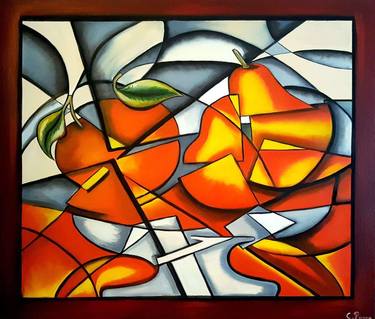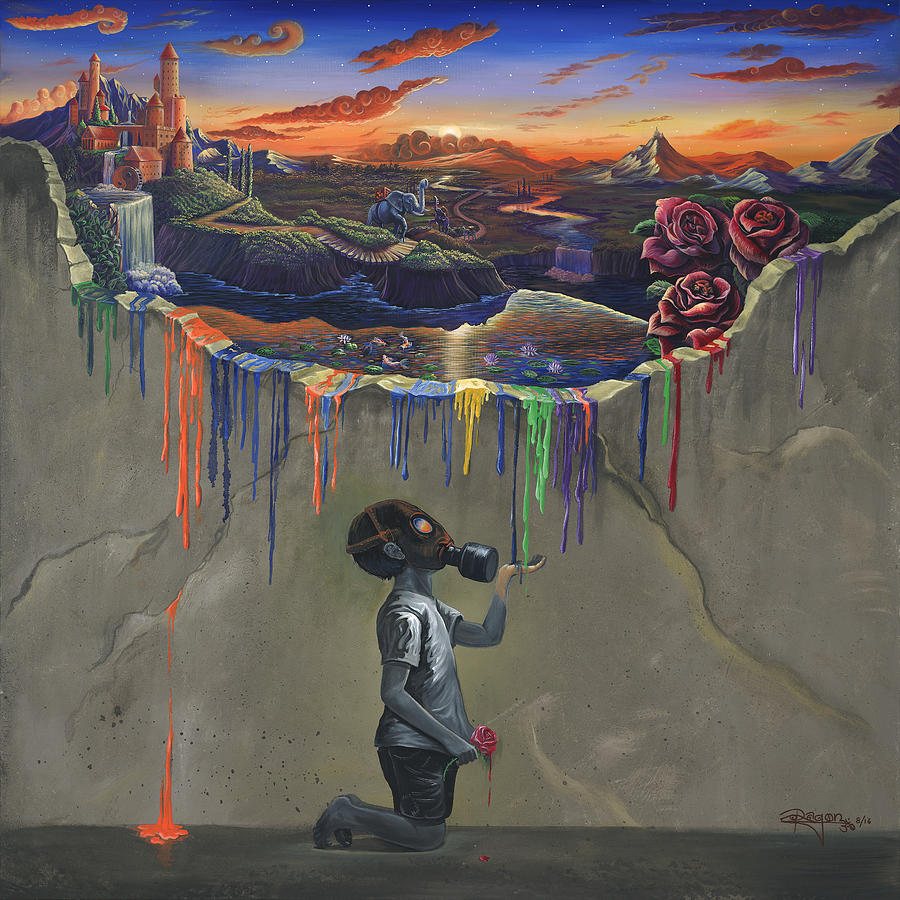Art Deco
Art deco is a design style from the 1920s and 1930s in furniture, decorative arts and architecture characterised by its geometric character. The art deco style, which above all reflected modern technology, was characterized by smooth lines, geometric shapes, streamlined forms and bright, sometimes garish colours.
Art Deco, sometimes referred to as Deco, is a style of visual arts, architecture and design that first appeared in France just before World War I. Art Deco influenced the design of buildings, furniture, jewelry, fashion, cars, movie theatres, trains, ocean liners, and everyday objects such as radios and vacuum cleaners. it features curving forms and smooth, polished surfaces. Art Deco is one of the first truly international styles, but its dominance ended with the beginning of World War II and the rise of the strictly functional and unadorned styles of modern architecture and the International Style of architecture that followed.
Expressionism
Expressionist art tried to convey emotion and meaning rather than reality. Each artist had their own unique way of “expressing” their emotions in their art. In order to express emotion, the subjects are often distorted or exaggerated. At the same time colours are often vivid and shocking. Expressionism is a modernist movement, initially in poetry and painting, originating in Germany at the beginning of the 20th century. Its typical trait is to present the world solely from a subjective perspective, distorting it radically for emotional effect in order to evoke moods or ideas.

Expressionism is a modernist movement, initially in poetry and painting, originating in Germany at the beginning of the 20th century. Its typical trait is to present the world solely from a subjective perspective, distorting it radically for emotional effect in order to evoke moods or ideas. Expressionist artists have sought to express the meaning of emotional experience rather than physical reality. Expressionism developed as an avant-garde style before the First World War.
Futurism
Futurism was an artistic and social movement that originated in Italy in the early 20th century. It emphasised speed, technology, youth, violence, and objects such as the car, the airplane, and the industrial city. Futurism, Italian Futurismo, Russian Futurizm, early 20th-century artistic movement centred in Italy that emphasized the dynamism, speed, energy, and power of the machine and the vitality, change, and restlessness of modern life.

Futurism was an artistic and social movement that originated in Italy in the early 20th century. It emphasised speed, technology, youth, violence, and objects such as the car, the airplane, and the industrial city. Futurism is an avant-garde movement founded in Milan in 1909 by the Italian poet Filippo Tommaso Marinetti. Russian Futurism was a movement of literature and the visual arts. The poet Vladimir Mayakovsky was a prominent member of the movement.
Dada
Dada or Dadaism was an art movement of the European avant-garde in the early 20th century, with early centers in Zürich, Switzerland, at the Cabaret Voltaire; New York Dada began circa 1915, and after 1920 Dada flourished in Paris. Dada was an art movement formed during the First World War in Zurich in negative reaction to the horrors and folly of the war. The art, poetry and performance produced by dada artists is often satirical and nonsensical in nature.

Dada was an informal international movement, with participants in Europe and North America. The beginnings of Dada correspond to the outbreak of World War I. For many participants, the movement was a protest against the bourgeois nationalist and colonialist interests, which many Dadaists believed were the root cause of the war, and against the cultural and intellectual conformity—in art and more broadly in society—that corresponded to the war. Dada emerged from a period of artistic and literary movements like Futurism, Cubism and Expressionism; centered mainly in Italy, France and Germany respectively, in those years. However, unlike the earlier movements Dada was able to establish a broad base of support, giving rise to a movement that was international in scope.
Cubism
Cubism is an early-20th-century avant-garde art movement that revolutionised European painting and sculpture, and inspired related movements in music, literature and architecture. Cubism has been considered the most influential art movement of the 20th century. a style of painting and sculpture developed in the early 20th century, characterised chiefly by an emphasis on formal structure, the reduction of natural forms to their geometrical equivalents, and the organisation of the planes of a represented object independently of representational requirements.

Cubism is an early-20th-century avant-garde art movement that revolutionized European painting and sculpture, and inspired related movements in music, literature and architecture. Cubism has been considered the most influential art movement of the 20th century. The term is broadly used in association with a wide variety of art produced in Paris during the 1910s and throughout the 1920s.
Surrealism
Surrealism is a cultural movement that started in 1917, and is best known for its visual artworks and writings. Artists painted unnerving, illogical scenes with photographic precision, created strange creatures from everyday objects, and developed painting techniques that allowed the unconscious to express itself. a style of art and literature developed principally in the 20th century, stressing the subconscious or nonrational significance of imagery arrived at by automatism or the exploitation of chance effects and unexpected juxtapositions.

Surrealism is a cultural movement that started in 1917 , and is best known for its visual artworks and writings. Artists painted unnerving, illogical scenes with photographic precision, created strange creatures from everyday objects, and developed painting techniques that allowed the unconscious to express itself. Its aim was to “resolve the previously contradictory conditions of dream and reality into an absolute reality, a super-reality”.
Modernism
Modern art includes artistic work produced during the period extending roughly from the 1860s to the 1970s, and denotes the styles and philosophy of the art produced during that era. The term is usually associated with art in which the traditions of the past have been thrown aside in a spirit of experimentation. Modernism, in the arts, a radical break with the past and the concurrent search for new forms of expression. Modernism fostered a period of experimentation in the arts from the late 19th to the mid-20th century, particularly in the years following World War I. ModernismLearn about Modernism in art and design.

Modernism is both a philosophical movement and an art movement that, along with cultural trends and changes, arose from wide-scale and far-reaching transformations in Western society during the late 19th and early 20th centuries. Among the factors that shaped modernism were the development of modern industrial societies and the rapid growth of cities, followed then by reactions of horror to World War I.
Abstract Expressionism
Abstract expressionism is a post–World War II art movement in American painting, developed in New York in the 1940s. It was the first specifically American movement to achieve international influence and put New York City at the center of the western art world, a role formerly filled by Paris. Abstract expressionism is the term applied to new forms of abstract art developed by American painters such as Jackson Pollock, Mark Rothko and Willem de Kooning in the 1940s and 1950s. It is often characterised by gestural brush-strokes or mark-making, and the impression of spontaneity.
:max_bytes(150000):strip_icc()/jm-aa_08_08-57a9c0ef5f9b58974a227328.jpg)
Abstract expressionism is a post–World War II art movement in American painting, developed in New York in the 1940s. It was the first specifically American movement to achieve international influence and put New York City at the center of the western art world, a role formerly filled by Paris. Although the term “abstract expressionism” was first applied to American art in 1946 by the art critic Robert Coates, it had been first used in Germany in 1919.
Pop Art
Pop art is an art movement that emerged in the United Kingdom and the United States during the mid- to late-1950s. The movement presented a challenge to traditions of fine art by including imagery from popular and mass culture, such as advertising, comic books and mundane cultural objects. The subject matter became far from traditional “high art” themes of morality, mythology, and classic history; rather, Pop artists celebrated commonplace objects and people of everyday life, in this way seeking to elevate popular culture to the level of fine art.

Pop art is an art movement that emerged in the United Kingdom and the United States during the mid- to late-1950s. The movement presented a challenge to traditions of fine art by including imagery from popular and mass culture, such as advertising, comic books and mundane cultural objects. One of its aims is to use images of popular (as opposed to elitist) culture in art, emphasizing the banal or kitschy elements of any culture, most often through the use of irony.
Post Modernism
Postmodernism is a broad movement that developed in the mid- to late 20th century across philosophy, the arts, architecture, and criticism, marking a departure from modernism. The term has been more generally applied to the historical era following modernity and the tendencies of this era. Postmodern art is a body of art movements that sought to contradict some aspects of modernism or some aspects that emerged or developed in its aftermath. In general, movements such as intermedia, installation art, conceptual art and multimedia, particularly involving video are described as postmodern.

Postmodern art is a body of art movements that sought to contradict some aspects of modernism or some aspects that emerged or developed in its aftermath. In general, movements such as intermedia, installation art, conceptual art and multimedia, particularly involving video are described as postmodern. Postmodernism describes movements which both arise from, and react against or reject, trends in modernism. General citations for specific trends of modernism are formal purity, medium specificity, art for art’s sake, authenticity, universality, originality and revolutionary or reactionary tendency.
1990’s Brit Art (YBA)
The first use of the term ‘young British artists’ to describe the work of Hirst and these other young artists was by Michael Corris in Artforum, May 1992. The acronym ‘YBA’ was coined later in 1996 in ArtMonthly magazine. The consolidation of the artists’ status began in 1995 with a large-scale group exhibition Brilliant! held at the Walker Art Center a respected art museum in Minneapolis, USA. The term YBA was already used in 1994 and later used by Simon Ford in a feature Myth Making in March 1996 in Art Monthly magazine.
